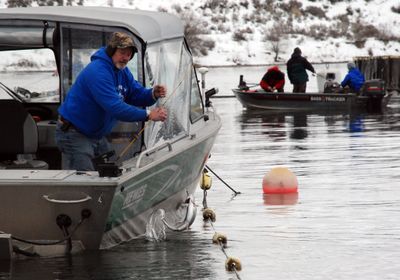Anglers think deep at Rufus Woods

Last year’s outrageously good fishing has toned down to simply good fishing for porky rainbows in the Columbia River waters of Lake Rufus Woods.
Tens of thousands of trout that escaped from a commercial net-pen operation going through financial disaster in 2007 have been thinned out, spread out or expelled with water through Chief Joseph Dam.
But that leaves many thousands still available to be caught, sometimes by the dozens. The average rainbow runs 4-8 pounds.
“With all those escapees, we didn’t put in our normal fish plants in 2008,” said Joe Peone of the Colville Tribe’s Fish and Wildlife Department. But the Tribe plans to resume its normal triploid rainbow stocking in February or March by releasing a couple of thousand tagged fish each month through September.
A visit last week found anglers fishing in a variety of ways, sinking jigs and bait, trolling, drifting and casting flies.
Three fishermen from Western Washington were conducting a clinic on how to catch these trout near the upper net pens that are being restored under new management by Pacific Seafood Group.
Incidentally, the triploid rainbows being raised in these pens won’t be harvested and sold commercially until sometime this summer, said Brian Jerlad, Pacific Seafood branch manager in Spokane.
“When we took over the operation last year, there were holes in the nets, fish were escaping and the fish that were still in the pens hadn’t been fed regularly; they weren’t in good shape,” he said. “So we’re spending a lot of money to get things up and running again and get the fish back to a healthy stage.”
These and other large pen-raised trout that come out of Canada are marketed as steelhead, he said.
But the free-roaming fish outside the net pens are in excellent shape, as one can see by their Sumo wrestler girth.
Noting that they’d driven 31/2 hours to the boat launch on Rufus Woods, one of three anglers from Snohomish said, “It’s worth every minute.”
The anglers seemed to be hooking and releasing large rainbows every few minutes as they anchored among other boats near the net pens.
They were asked to move outside a buoyed buffer zone when net-pen workers came to feed the fish.
But they didn’t need to be so close. Relocated, they kept catching fish faster than any of the half-dozen boats in the vicinity.
Their tactic: Drop-shotting, with a ½- to ¾-ounce weight at the end of the line, depending on the pulsing current coming down from Grand Coulee Dam, and various soft-plastic lures rigged up the line about 18 inches.
The heavy weight allowed them to get down quickly near their boat in 40 feet of water with a significant current.
Another angler nearby was catching fish using a slip sinker and a worm with PowerBait to float his hook above the bottom.
But since he was using bait, he had to keep each fish he caught up to his two-fish limit.
The anglers fishing the artificial lures caught and released fish for hours until they kept their limits at the end of the day.
Fly fishers in the area were not doing so well that day, but that doesn’t mean they’re not effective.
“It’s slowed down recently, but we still released six or eight apiece,” said George Potter, who was out with a partner two weeks ago. That’s down from 20-25 fish apiece during the 2008 bonanza.
“Every day is different, but the pressure is down, and that makes the fishing more pleasant,” he said.
Potter’s proven fly-fishing tactic involves a Rio Deep 7 fly line that’s thin to reduce the effect of current and extremely fast-sinking — 7 to 9 feet per second.
“We anchor and cast big weighted nymphs and dark bushy flies downstream and retrieve them back slowly just off the bottom.”
Some fly fishers admit to tying “pellet patterns” that resemble the fish food that sifts through the net pens when the commercial fish are being fed.
Asked if they had any of those patterns available for sale, several area fly shop owners chuckled and said not, or at least not over the counter.
“A fly fisherman can only stoop so low,” said Allen Peterson of Swede’s Fly Shop. “I won’t go so far as to tie a dog-food fly.”